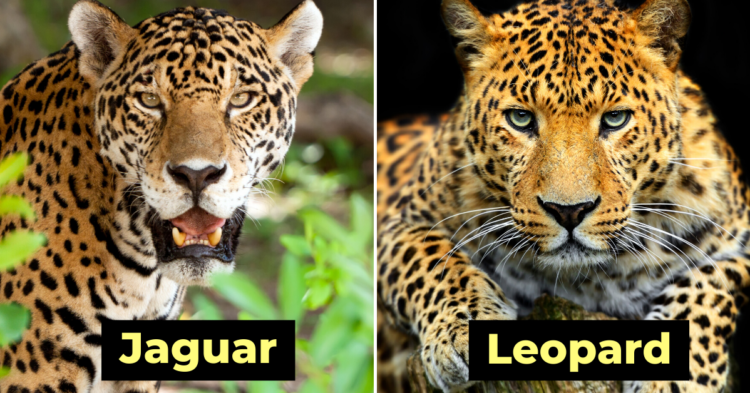Okay, is it just me or do some of the species we see in the animal kingdom look like someone just hit “copy” and “paste”? All creatures are beautiful and incredible in their own way, of course, but a few definitely seem like they could be twins.
Unfortunately for those particular animal pairs, we humans have a habit of getting them helplessly mixed up. We’re like that grandmother that keeps calling her twin grandchildren by each other’s names, and at first it was funny but now it’s like, “Seriously grandma? You can’t tell us apart?”
At this point, it’s almost insulting . So let’s all take a moment to differentiate between some of the most commonly mixed-up animal pairs before they go through some sort of rebellious teenage phase and dye their hair black to make themselves stand out.
Alligator VS. Crocodile

Okay, we’re starting out with a tough one here. At first glance, there doesn’t seem to be much of a difference between these two prehistoric-looking animals. But upon closer inspection (definitely not recommended), you would see alligators have U-shaped mouths while a crocodile’s snout is more V-shaped, and shows off a toothier grin.
They also differ when it comes to size, speed, and behavior.
Hare VS. Rabbit

While both long-eared and adorable in their own right, hares and rabbits are are actually two pretty different animals. For starters, hares have not been domesticated yet, and are faster and larger than rabbits. They also have longer ears, stronger hind legs, and bigger feet.
So if you’re like me and always thought “hare” was just another word for “rabbit”, you’d be wrong.
Llama VS. Alpaca

Both lamas and alpacas are part of the Camelidae family, but while they may be related, they’re definitely not the same.
Llamas are larger with banana-shaped ears, while alpacas are smaller with pointed ears; llamas have long faces with less fur, and alpacas have short faces with lots of fur; alpacas are shy, and llamas are independent.
And, of course, Emperor Kuzko was turned into a llama, not an alpaca. So there you go.
Dolphin VS. Porpoise

One of the best ways to tell a dolphin from a porpoise is to look at its head. A dolphin’s noggin is more bulbous with a defined “beak”, whereas a porpoise has a more rounded head without a beak.
Can’t see their head? Just look at their fins. Dolphins have curved dorsal fins, while porpoises have triangular-shaped ones.
Seal VS. Sea Lion

So here’s a fun fact: apparently seals and sea lions are “second cousins”. Along with walruses, these sea mammals are part of the “pinnipeds” family, meaning “fin footed” in Latin.
How can you tell these distant cousins apart? Well, there are actually many ways. Sea lions have small flaps for outer ears and seals have none; sea lions are noisy, while seals are much quieter; and sea lions can use their hind flippers to help them “walk” on land, whereas seals are mostly just belly-crawlers while out of the water.
Wasp VS. Hornet

Neither one of these winged insects are very friendly, but from a physical perspective, they differ by size (hornets are larger), color (hornets are orange and black while wasps are black and yellow), and pattern (hornets looked spotted while wasps looked striped).
A good rule of thumb? Just avoid both of these guys. It’s really not worth distinguishing them if you get stung in the process.
Turtle VS. Tortoise

Perhaps my favorite difference between a turtle and a tortoise is their feet — turtles have itty-bitty webbed feet, whereas tortoises look like they have mini elephant feet attached to their bodies.
Besides that adorable fact, turtles mostly live in water while tortoises like to stay inland, and turtles have flatter, streamlined shells versus a tortoise’s heavier, dome-like shell.
Frog VS. Toad

One good way to tell a frog apart from a toad is to look at their skin — frogs have smooth, mucus-coated skin that gives them a “wet” appearance, while toads have rougher, thicker, and bumpier skin.
Another indicator is the amphibian’s eyes. Frogs have higher eyes that are rounded and almost bulgy-looking, whereas a toad’s eyes are lower and more football-shaped, giving them a dull, perpetually unimpressed expression.
Butterfly VS. Moth

You may think you can tell a butterfly from a moth , but there are actually a few outliers from both families that can easily be mistaken for one another.
From a behavioral standpoint, butterflies are diurnal, meaning they’re active during the day, while moths prefer a more nocturnal way of life. But another good way to differentiate these two is from their wings — butterflies fold theirs over their backs while they rest, and moths adopt a more tent-like position with their wings folding over their abdomens.
African Elephant VS. Asian Elephant

Alright, this one might seem unfair since they’re both technically elephants , but I think it’s an important distinction to make because they’re actually very different from one another.
Of course, their names reveal the biggest difference: location . But there are physical ones, too. Elephants from Africa are bigger with wider, fan-shaped ears, and both the male and females grow tusks, whereas only some male Asian elephants grow tusks. Asian elephants also have a distinctly humped skull, versus their African counterparts’ smooth, flatter heads.
Sheep VS. Goat

While certainly similar, sheep and goats actually differ greatly. Most goats have fur while sheep have wool; goats’ tails point upwards while a sheep’s points down; and sheep graze on grass while goats prefer to munch on low-hanging tree leaves.
Puffin VS. Penguin

While they do share similar colors, puffins and penguins aren’t even from the same family: penguins belong to the Spheniscidae family, while puffins are part of the family Alcidae.
Another difference, perhaps the most obvious, is that puffins like to soar the skies while poor, poor penguins are tragically flightless. Puffins are also smaller than penguins and live in the Northern Hemisphere, whereas penguins live in the Southern Hemisphere.
Octopus VS. Squid

Just like seals and sea lions, squids and octopuses are cousins, just not siblings . They’re both part of the cephalopoda group, and they both have arms or tentacles but no vertebrae.
But here’s the real difference that might surprise you: octopuses have eight arms, while squids have eight arms and two longer tentacles, which they use to catch fish and shrimp. They also tend to congregate in schools and live longer than octopuses.
Jaguar VS. Leopard

When it comes to telling a jaguar from a leopard , it really comes down to the teeny-tiny details. For instance, leopards live in African savannas, while you’re more likely to find a jaguar in South American tropical forests.
Physically-speaking, jaguars are stockier than leopards with broader heads, more powerful jaws, and shorter tails; both have rosette patterns, but a jaguar’s has spots inside of them; and while both can swim, a jaguar loves to splash around in the water while a leopard would much rather just avoid that nonsense altogether.

















































